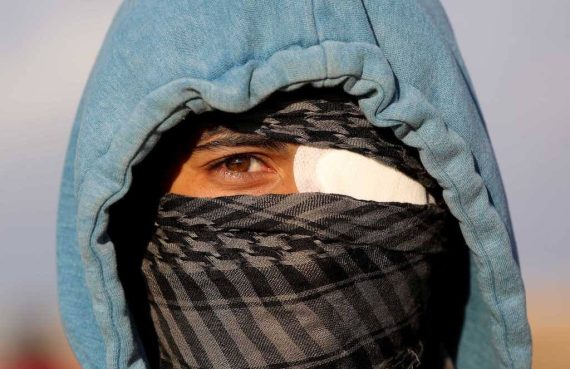A young Palestinian man leans on his crutch after having his leg amputated. Despite being shot and no longer being able to walk, Mohammed Elakhras, 33, sits on the front row of a football stadium to watch a local game between the Rafah and Gaza teams. He always hoped to be a football player. In his teenage years, he played for his school team and participated in tournaments. However, his dream of competing internationally was cut short after he was shot by an Israeli sniper while taking part in the Great March of Return (GMR), which began four years ago on March 30, 2018.
A generation on crutches
With one leg, and on his crutch, Mohammed’s dream will never come true. Israeli snipers amputated Mohammed’s dream along with his leg.
Whenever Mohammed watches a football match on TV or meets a group of people playing football in the street or at a stadium, he remembers his suffering.
The Ministry of Health in Gaza has declared that there are about 136 amputees in Gaza after the beginning of the GMR with 122 losing their lower limbs and 14 their upper limbs.
The lives of people with such complex injuries are dramatically affected: most have lost their jobs due to their disabilities while families often struggle to come to terms and provide for them.
Shot at the Gaza border
Mohammed took part in a peaceful protest as part of the Great March of Return, on May 25, 2018, which called for an end to Israel’s ongoing siege on Gaza. When he was shot, he was standing at the border looking at the other side where Israeli snipers were stationed. His fault, he says, was carrying a Palestinian flag which prompted an Israeli sniper to shoot him in the leg.
Palestinian paramedics weren’t able to reach Mohammed immediately to help him due to the shower of bullets by the same snipers that targeted anyone who attempted to get closer to him. Mohammed bled on the ground for quite some time.
Mohammed managed to reach a hospital late. His injury was severe, and the hospital was not equipped to deal with severe injuries. As a result, the only solution to save his life was to amputate his leg according to the doctors. His family had to accept the doctors’ decision.
I have a dream
“My dream is to accompany my wife and my daughter for a walk along the beach and to carry my daughter and go with her to buy her clothes and toys from the market. I wish I could stand and throw my little one in the air and catch her again. It is simply impossible to do this with one leg,” says Mohammed.
Mohammed’s mother added that Israel deprived her son of living normally and enjoying his life to the fullest. “All he has now is sympathy and pity from people. His artificial leg can’t be an alternative and compensate for his real leg,” she says.
Losing an arm
Nidal Almoghair, 33, is another example of a forsaken dream. He was the team captain of the volleyball team in his school. Nidal lost his right arm when he noticed a strange object near his house in the first offensive on Gaza in 2008. He touched it, and his arm flew into the sky, shattered to pieces. He was 17 years old at the time, returning from school.
Nidal couldn’t complete his studies and attempted to commit suicide. He had always dreamt of being a mechanical engineer. His amputation also cost him his dream of participating in an international volleyball competition.
Nidal notes, “It’s difficult to live a normal life as I used to, but it’s my destiny and I have to accept it.” “I even forget that I have an artificial arm,” he adds.
“You know, I haven’t succeeded in staying in a job for more than a month because of my disability. Now, I’ve been married for two years. My wife is pregnant, and I don’t know how I will look after her and my child.”
Recommended
The eldest son, now disabled
Fadi Abu Shaar, 21, lost his leg on March 22, during the GMR.
Fadi is the eldest son in his family. He was a freshman at Al-Quds Open University in the law department, and worked at a market near his family’s home to cover his tuition fees, feed his family, and pay for his sick father’s medicine.
“After losing my leg, I kept moving from one hospital to another to get medical care as the hospitals here in Gaza are poorly equipped. I missed many lectures and exams, and I couldn’t catch up with others.” “Then I left university,” he says with a tone full of sorrow.
Fadi’s mother added that their economic situation became difficult as he lost his job and spent all his savings on medical treatment.
“My brother became depressed and lost his sense of humor. His laugh used to fill our house. He was full of energy, but now all this is gone,” his 15-year-old sister Amany tells us.

VIDEO: Nakba Survivors Speak: “The sky was our blanket and the ground was our mattress”
Adapting to new life
Nidal, Mohammed, and Fadi are trying to adapt to their new realities. Although Mohammed and Nidal speak of their stories of suffering, many others refuse to talk about their injuries because of reliving the trauma. They are still afraid of being tracked by the Israeli occupation, and also don’t want people feeling sorry for them.
It’s normal for someone who lives in a post-traumatic situation not to speak up. Many amputees fear social stigma and prefer not to talk about their injuries. Seeing a mental health professional is more challenging as the local community considers seeking help by a professional as a sign of weakness mental illness, both of which still hold negative connotations.
On the fourth anniversary of being shot at the Great March of Return, will time be their best remedy? And will justice ever be served?





